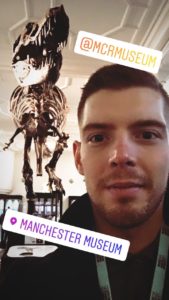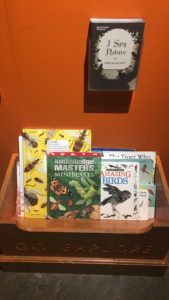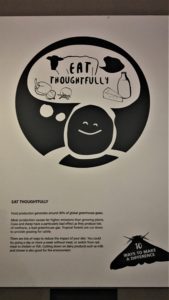The Manchester Museum is the UK’s leading university museum with a varied collection ranging from natural history to technology. As part of my visit I was looking out for practical examples that relate to our science engagement reflection points.
People
 Upon arrival at the museum, I am quickly immersed in the Fossil Gallery. Stan the T. Rex stands proudly in the centre of the gallery igniting imagination and curiosity in everyone who looks at him. Within the text accompanying Stan, there is a well-presented nod to all those who helped excavate him and the roles they played. From the palaeontologists who made the cast of the bones to the welders who mounted them, each profession is thoughtfully explained. This allows visitors to recognise and broaden their perception of the people who are involved in STEM.
Upon arrival at the museum, I am quickly immersed in the Fossil Gallery. Stan the T. Rex stands proudly in the centre of the gallery igniting imagination and curiosity in everyone who looks at him. Within the text accompanying Stan, there is a well-presented nod to all those who helped excavate him and the roles they played. From the palaeontologists who made the cast of the bones to the welders who mounted them, each profession is thoughtfully explained. This allows visitors to recognise and broaden their perception of the people who are involved in STEM.
Extend the experience
 Emerging from the Fossils Gallery I moved to the Nature Discovery gallery. This activity area, linked to the Living Worlds Gallery, takes the form of a cosy den and encourages the under 5s and their grown-ups to explore the natural world. Walking in, you are presented with a box of children’s books relevant to the exhibit which families can use to make connections with the display. The ‘I-spy nature’ activity leaflet inspires children to look for animals high and low, inside the gallery and beyond, allowing visitors to take their questions and conversations home with them and extend their experience.
Emerging from the Fossils Gallery I moved to the Nature Discovery gallery. This activity area, linked to the Living Worlds Gallery, takes the form of a cosy den and encourages the under 5s and their grown-ups to explore the natural world. Walking in, you are presented with a box of children’s books relevant to the exhibit which families can use to make connections with the display. The ‘I-spy nature’ activity leaflet inspires children to look for animals high and low, inside the gallery and beyond, allowing visitors to take their questions and conversations home with them and extend their experience.
Everyday examples and Promote STEM Talk
 Moving on to the provocative Living World gallery, I was struck by some poignant facts about the effect humans have had on the natural world. By using everyday examples, this gallery gets visitors to consider their impact on the natural world and reflect on what they can do to reduce it. The stimulating content of the gallery helps to promote ‘STEM’ talk by encouraging visitors to share their own experiences around the themes presented in the gallery.
Moving on to the provocative Living World gallery, I was struck by some poignant facts about the effect humans have had on the natural world. By using everyday examples, this gallery gets visitors to consider their impact on the natural world and reflect on what they can do to reduce it. The stimulating content of the gallery helps to promote ‘STEM’ talk by encouraging visitors to share their own experiences around the themes presented in the gallery.
During my day out at the Manchester Museum I saw some wonderful examples of good science engagement practice and I certainly had lots of fun! Have you seen any examples of good practice? Get in touch and share them with us!
In our ‘out and about‘ series we go searching for examples of good science engagement practice.